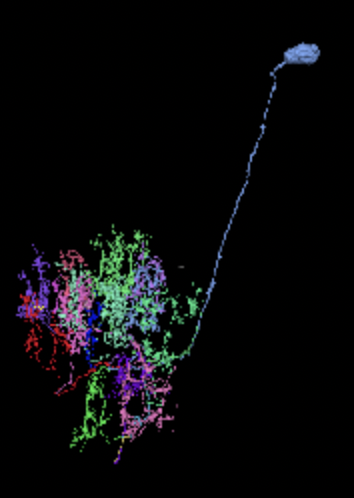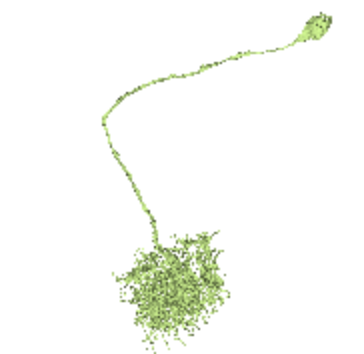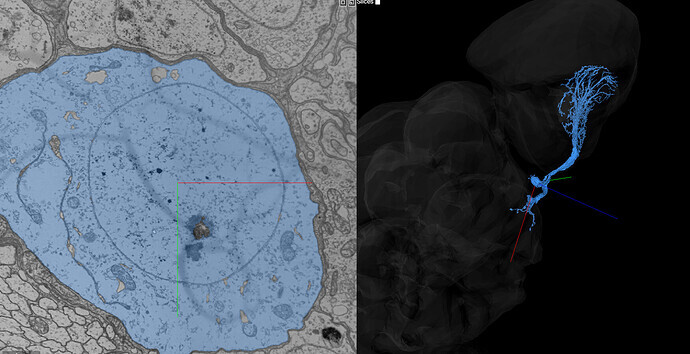Could this be an Mi 2?
https://ngl.flywire.ai/?json_url=https://globalv1.flywire-daf.com/nglstate/5851282438881280
Could this be an Mi 2?
https://ngl.flywire.ai/?json_url=https://globalv1.flywire-daf.com/nglstate/5851282438881280
And another question:
Lpi?
https://ngl.flywire.ai/?json_url=https://globalv1.flywire-daf.com/nglstate/6199039431278592
I am thinking that your cell is closest to a Mi 2, but the illustrations look like they might have a bigger axonal cluster (found another branch FlyWire making it a little better. )
the alternative is one of the Mi cells we do not have any illustration of
for the other cell i think Lpi looks like a safe bet
With the missing (now merged) branch it looks better, indeed. Thanks.
I’m trying to find all the missing (from spreadsheet) Mi’s, but it’s a little harder, than I thought.
yeah it is a bit searching blind if you can´t find it in the database
i am trying to identify the Pm cells and is thinking that this might be good exsamles
Pm 1 FlyWire

Pm 2 FlyWire

Pm 3 have not been able to find out how this is supposed too look
Pm 4 already sure identification FlyWire

also have this one with a gap in the middle FlyWire
another pm 1 or could it be a pm 3?
According to this picture
Pm3 should have wider arborization, more alongated, so on the last picture is probably a Pm 1.
As for the rest of the Pm’s, I agree.
Found this curious cell
https://ngl.flywire.ai/?json_url=https://globalv1.flywire-daf.com/nglstate/6264672839794688
i am thinking this might be a Optic lobe tangential (Olt)
Looks similar to Olt, but, according to Fischbach, Olt should have its neurite (connection to soma) go through the inner optic chiasm, while this one has it on the other end. I’d guess, that it might be a Tm cell, but didn’t found one, that has only one arborization in medulla and lying so low (close to lobula) in it.
Hey all, I just wanted to say that we are seeing these posts and I’m sorry that we don’t have answers - as it turns out, no one in Seung Lab is extremely familiar with the drosophila optic lobe so we aren’t much help in identifying. I will continue to ask around and see if we can find answers. It looks like you all are well on the way to becoming experts though!
I did hear some cool stats at a meeting yesterday: the central brain is almost fully proofread (~60,000 neurons). Of those, roughly half have some cell identification information. That means that a full 30,000 neurons have no type info! And there’s a good chance that many of those are new and never before seen! This may also be true of neurons in the optic lobe.
@annkri @Krzysztof_Kruk I came across a similar cell, with the same overall morphology (i.e. same style of dendritic arbor, with three axonal neurites terminating in similar axon bundles), but in a completely different location (e.g. soma location, arbor locations, etc.). I haven’t spent any time identifying it yet, but I’m wondering if it is of the same type as the cell you presented above…just, associated with different areas of the brain?
https://ngl.flywire.ai/?json_url=https://globalv1.flywire-daf.com/nglstate/6021388309626880
ive seen/completed some of those as well. Always make me think its a merger, lol.
@Nseraf lol, same here, that’s what I thought at first, too…still not entirely sure, so I thought I’d mention it here.
I wonder, if this could be a Pm3:
https://ngl.flywire.ai/?json_url=https://globalv1.flywire-daf.com/nglstate/6062719987875840
The description here seems to be a match: http://flybase.org/cgi-bin/cvreport.pl?id=FBbt%3A00110066
TR77 i am thinking your cell is close to a Y(1) type but maybe a undiscovered variant with two arbours in the medula instead of 1
KK i do not think this is a Pm cell at all according to this picture https://cob.silverchair-cdn.com/cob/content_public/journal/dev/138/5/10.1242_dev.058370/3/dev058370f4.jpeg?Expires=1661433990&Signature=UPyjzNtck4o-5YdA56Y273wUCvKWVY5eO79XmdAqafQf0pAKyLHraaFKsVFJQQ8k~X5Uv9U4zZL1fBKins24aeYHNbzqOmwVWHRlLGpfLHOCgJr5WpKBHVlYjQZsbIeumBUBUdAnYuaMi3Cw8cPwTg3Zys8QjagXqhG~FVBWt8TNp1~k0CQXMOw7yju~0Bk58BB-hTdvJuHmLbkanctU8BiUmK1raAQFyCEmvXyvxhNTDXIIChqQp77Lxw1FxmCHxD219NuB5RpYGVEAENqaaJNpk1LBPo15uCsV4d75nTkYTp11wyiIjyWiTOZsSXXaaMJL0kuktJRRCFTIFmcarA__&Key-Pair-Id=APKAIE5G5CRDK6RD3PGA
the soma should go up against the medulla and not flat like that.
Also all the Pm cells i have seen is buquet types with the branches running paralell for a while before splitting of.
i am thinking this might be closer to a Mt cell, but not any of the ones pictured in fishback
Tm1??? (if anyone has a minute to check me on this)
Also, thanks @annkri for identifying the above as Y1. I’ll go back and check the medulla arbors…one of them still may be a merger. ![]()
https://ngl.flywire.ai/?json_url=https://globalv1.flywire-daf.com/nglstate/6106409494118400
Added in what is identified as a Tm1 in the guide in purple, but from what i can see that is actually a Tm1a (cb goes toward lobula/central brain) while yours is the Tm1 cells
https://ngl.flywire.ai/?json_url=https://globalv1.flywire-daf.com/nglstate/6016579623976960
I can’t seem to find the post where this cell was shared, but we do have ID for this one. Maybe it was from @Krzysztof_Kruk?
Emil Kind says “this is a a LPTC neuron (lobula plate tangential cell). Its a larger group of large-field motion-sensitive neurons. There are for example VS and HS LPTCs which are vertically sensitive (VS) or horizontally sensitive (HS). They all get input from T4 and T5.”

https://ngl.flywire.ai/?json_url=https://globalv1.flywire-daf.com/nglstate/4998700761874432